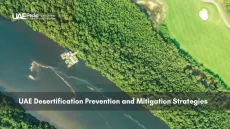What if we told you the UAE’s most stunning secrets aren’t buried in sand? Beyond the shimmering dunes lies a rugged world of jagged peaks, hidden trails, and stories etched into ancient rock. While the diverse landforms of the UAE include deserts and coastlines, the Hajar Mountains stretch across the eastern horizon like a geological masterpiece—offering hikes, vistas, and cultural discoveries that defy expectations.
This guide isn’t just about trails—it’s about experiences. Imagine standing atop Jebel Jais, where the air feels crisper and the views stretch to Oman. Picture tracing paths through wadis that bloom after rare rains, their limestone walls whispering tales of Bedouin heritage. We’ll show you where to find these moments, blending insider tips with the science behind the scenery.
Whether you’re a seasoned hiker or a curious traveler, the Arab Emirates’ peaks promise adventure. From Jebel Hafeet’s serpentine roads to fossil-rich ridges near Ras Al Khaimah, every route reveals a new side of this country. Ready to trade skyscrapers for summit views? Let’s begin.
Key Takeaways
- Discover hidden trails and panoramic viewpoints across the Hajar range, including Jebel Jais and Jebel Hafeet.
- Learn how geology and culture shape the United Arab Emirates’ mountain landscapes.
- Grab practical tips for hiking safely while respecting local ecosystems and traditions.
Exploring the Majestic Landscape
There’s a secret spine running through the Emirates—carved by millennia of tectonic shifts and erosion. The Hajar Mountains form a 700-kilometer backbone stretching from Oman into the northern reaches of the United Arab Emirates. This rugged realm isn’t just scenery—it’s a living archive where geology meets human history.
Where Stone Tells Stories
Born 70 million years ago, these peaks are made of oceanic crust thrust upward—a rare sight in arid regions. You’ll find limestone cliffs stacked like pages and wadis that flash to life after winter rains. Near Ras Al Khaimah, the range divides desert plains from fertile valleys, creating microclimates where date palms thrive.
Climate’s Dance With Rock
Summers here sizzle at 104°F, but higher altitudes offer cooler escapes. Winter temperatures dip to 59°F, perfect for hiking. The mountains act as nature’s water towers, capturing fog and channeling groundwater to nearby towns. “Without these peaks, the desert would dominate,” notes a local geologist—proof that even in dry lands, elevation writes survival rules.
This region’s layered terrain—from jagged summits to fossil-rich slopes—invites exploration. Trails reveal 4,000-year-old petroglyphs and villages clinging to cliffsides. Every step through the Hajar range feels like turning pages in the United Arab Emirates’ untold storybook.
Discovering UAE Mountains: Top Hiking Trails and Scenic Viewpoints
Ready to swap cityscapes for heart-pounding vistas? The United Arab Emirates hides trails that zigzag between camel-shaped ridges and valleys glowing with wildflowers. Let’s explore both bucket-list peaks and paths only locals whisper about—where every turn reveals why this mountain range defies desert stereotypes.
Iconic Peaks and Viewpoints
Jabal Hafeet isn’t just a peak—it’s a 4,000-foot limestone giant guarding Al Ain. Drive its 21 hairpin turns at sunrise, then hike the final mile to a summit where three nations blur into golden haze. “You’ll spot oasis farms below that look like emerald puzzle pieces,” says a frequent hiker.
Up north, Jebel Jais rules the Hajar Mountains as the Arab Emirates’ highest point. Its 4,700-foot Via Ferrata route mixes climbing cables with ridge walks—perfect for thrill-seekers. Pack gloves; the iron rungs get hot by noon.
Hidden Trails and Local Gems
Near Ras Al Khaimah, the secret Wadi Ghalilah trail rewards hikers with natural pools and 200-year-old watchtowers. Start early: shade vanishes by 10 AM. For a quieter Abu Dhabi escape, try Jebel Hafeet’s Backdoor Route—a rocky path where desert foxes dart between acacia trees.
| Trail | Location | Difficulty | Highlights |
|---|---|---|---|
| Jabal Hafeet Summit | Al Ain | Moderate | 360° desert-oasis views |
| Jebel Jais Via Ferrata | Ras Al Khaimah | Challenging | Cliffside cables & eagle sightings |
| Wadi Ghalilah | Northern Emirates | Easy | Historic towers & swimming holes |
Pro tip: Most trails lack water stations. Carry 3 liters per person—double that if you’re tackling the Hajar Mountains between October and April, when temperatures feel deceivingly mild. And always check regional maps; what looks like a quick hike might be a 5-hour rock scramble!
Immersing in Nature: Flora, Fauna, and Wadis
Step off the trail for a moment—listen. That rustle isn’t just wind. It’s the whisper of life thriving in one of Earth’s most surprising mountain ranges. Beyond the rockscapes, the Hajar range hides delicate ecosystems where rare species and seasonal waters rewrite desert survival rules.
Native Species and Biodiversity Hotspots
Meet the Arabian tahr—a nimble goat-antelope scaling cliffs like a furry Spider-Man. These endangered climbers share the peaks with sand cats and Bonelli’s eagles. Botanists geek out over the Moringa peregrina, a drought-defying tree whose oil heals burns. “These species are climate-change warriors,” says a Ras Al Khaimah conservationist. “They’ve adapted to extremes we’re just beginning to understand.”
| Species | Habitat | Unique Trait |
|---|---|---|
| Arabian Tahr | Steep cliffs | Rubber-like hooves |
| Christ’s Thorn Jujube | Wadi edges | Edible vitamin-C-rich fruit |
| Blanford’s Fox | Rocky slopes | Night vision for moonlit hunts |
Exploring Vibrant Wadi Ecosystems
When winter rains fall, dry riverbeds become liquid lifelines. Flash floods carve temporary pools where dragonflies dart and frogs chorus. These oases support 63% of the United Arab Emirates’ plant species—including medicinal herbs villagers have used for generations.
Hikers find wadis most magical at dawn. Sunlight filters through palm fronds, painting the water gold. But tread lightly: even footprints can disrupt fragile moss colonies. Stick to marked paths, and never remove rocks—they’re someone’s home.
Want to witness this dance of water and stone? Visit Wadi Tayyibah in Abu Dhabi after November rains. Just remember: these ecosystems aren’t theme parks. Take photos, not souvenirs, and let the desert’s quiet resilience reshape how you see the Arab Emirates’ wild heart.
Planning Your Adventure: Tips and Essential Preparations
Let’s talk brass tacks—prepping for the Hajar range isn’t about gear alone. It’s about dancing with the desert’s rhythm. Whether you’re eyeing Ras Al Khaimah’s ridges or Abu Dhabi’s hidden trails, smart planning turns challenges into triumphs.
Pack Smart, Not Heavy
Forget bulky backpacks. Local guides swear by this mantra: “Carry what sustains, leave what strains.” Essentials include:
- Hydration hacks: 4 liters of water per person (add electrolytes for summer hikes)
- Sun armor: UPF 50+ sleeves, wide-brimmed hat, and zinc oxide sunscreen
- Navigation duo: Offline maps + a physical compass—cell service vanishes past 1,000 feet
One hiker learned the hard way: “My phone died on Jebel Jais’ backside. Thank Bedouin stars I’d packed a paper map!”
Weather Whispers and Climate Clues
The Hajar Mountains’ weather plays chess, not checkers. Mornings can dawn at 68°F, then spike to 104°F by noon. Watch for these signs:
| Indicator | Meaning | Action |
|---|---|---|
| Sudden wind shifts | Dust storm approaching | Seek rock overhangs |
| Cumulus clouds by 10 AM | Afternoon thunderstorms | Descend immediately |
| Fog in wadis | Flash flood risk | Avoid low-lying areas |
“Check the Arab Emirates’ mountain forecast thrice: night before, at dawn, and midday,” advises a Ras Al Khaimah tour operator. Their free app updates every 30 minutes—a lifesaver when microclimates flip scripts.
Remember, respecting local customs is part of the journey. Ask before photographing villages, and leave ancient petroglyphs untouched. With the right prep, the United Arab Emirates’ peaks become less daunting and more dazzling—one careful step at a time.
The Cultural and Historical Significance of the Mountains
Long before GPS grids, stone peaks whispered where nations begin and end. The Hajar range’s ridges have shaped more than trails—they’ve drawn political lines and cultural identities for centuries. Here, every cliff tells two stories: one of survival, another of sovereignty.
Historical Borderlines and Local Traditions
In 1955, British surveyors traced the Hajar’s crest to separate the United Arab Emirates from Oman. “These peaks were nature’s barbed wire,” explains a historian from Abu Dhabi. Villagers still recall trading salt along routes that doubled as informal checkpoints—paths now marked by rusted rifle casings and wild almond trees.
Communities near Ras Al Khaimah celebrate this heritage through the Al Hejaz festival. Locals reenact ancient border negotiations using traditional star navigation. “Our grandparents used Orion’s belt to settle grazing disputes,” shares a third-generation guide. “Mountains weren’t barriers—they were meeting places.”
Insights from Topographic Maps and Historical Sources
Early 20th-century maps reveal how water sources dictated boundaries. British archives show 63% of border agreements referenced seasonal springs. Check this comparison of historical vs. modern mapping priorities:
| Era | Mapping Tools | Key Features | Impact |
|---|---|---|---|
| 1920s | Hand-drawn surveys | Water wells, grazing lands | Tribal territories defined |
| 2020s | Satellite imaging | Hiking trails, conservation zones | Tourism development |
Modern hikers in the Arab Emirates often stumble upon forgotten watchtowers—stone sentinels that once guarded trade routes. Near Abu Dhabi’s Al Dhafra region, 400-year-old falaj irrigation channels still funnel mountain water to date farms. “This isn’t archaeology,” laughs a farmer. “It’s tomorrow’s lunch.”
Final Thoughts for the Avid Mountain Explorer
Your boots crunch on ancient limestone—each step revealing why the Hajar Mountains captivate adventurers. From Jebel Jais’ dizzying heights to Abu Dhabi’s whispering wadis, these peaks blend geological wonder with living heritage. You’ve now got the tools: trail secrets, safety smarts, and cultural context to wander wisely.
Remember—pack light but plan thoroughly. Those 4 liters of water and sun protection aren’t suggestions; they’re survival gear. As you trace paths near Ras Al Khaimah or decode petroglyphs, tread like a guest. These landscapes aren’t just backdrops—they’re time capsules where every acacia tree and stone tower holds stories.
The United Arab Emirates’ peaks reward those who listen. Hear the wind’s tales in Wadi Ghalilah’s canyons. Spot the Arabian tahr’s fleeting shadow at dawn. Whether chasing summit highs or quiet valley moments, you’re part of a narrative stretching back millennia.
Ready to write your chapter? Lace up, respect the land, and let the Arab Emirates’ hidden trails surprise you. Adventure here isn’t just about the climb—it’s about carrying forward a legacy of wonder, one responsible footprint at a time.
The Hajar Mountains formed 70 million years ago, creating dramatic limestone cliffs and hidden wadis. Their elevation creates cooler microclimates, supporting rare species like the Arabian tahr. You’ll find fossilized coral reefs—proof this was once ocean floor!
Most trails don’t require permits, but check local advisories. Ras Al Khaimah’s Jebel Jais has marked routes with safety signage. Always register at trailheads—some routes close during extreme heat or wildlife breeding seasons.
Absolutely! Jabal Hafeet’s paved road leads to viewpoints perfect for sunrise snaps. For trails, Wadi Adventure in Al Ain offers guided routes with varying difficulty. Start early, carry 2L water per person, and wear grippy shoes for loose gravel.
Keep eyes peeled for Arabian red foxes, hedgehogs, and migratory birds like pallid scops owls. Wadis like Bih and Shawka bloom with acacia trees and wildflowers after rains. Never disturb nests or freshwater pools—they’re lifelines for ecosystems.
Ancient falaj irrigation systems in Al Hajar villages showcase early engineering. Local crafts like palm-frond weaving and mountain honey harvesting persist. Respect cultural sites—some caves near Masafi contain centuries-old petroglyphs.
Seek out Hatta’s secret paths like the Honeybee Trail or Fayah Mountain’s fossil hills. Fujairah’s Al Rabi Tower route rewards with coastal views. Local guides often share hidden gems—ask at cultural centers before heading out!
October to March offers crisp nights with minimal humidity. Jebel Jais’s Astronomy Nights and Al Quaa’s Dark Sky Reserve near Abu Dhabi provide epic vistas. Pack layers—desert temps drop sharply after sunset.
Yes! Jebel Al-Heben near Hatta marked historical Omani-Emirati boundaries. Look for restored watchtowers—some date to the Bronze Age. Topographic maps at Ras Al Khaimah’s National Museum reveal how terrain shaped trade routes.
Dress modestly near villages, avoid photographing locals without consent, and leave no trace. Many trails pass through protected areas or private farms—stick to marked paths. A simple “shukran” (thank you) goes far with communities!


















